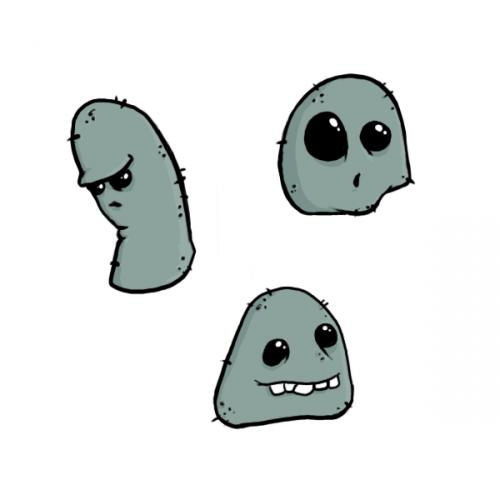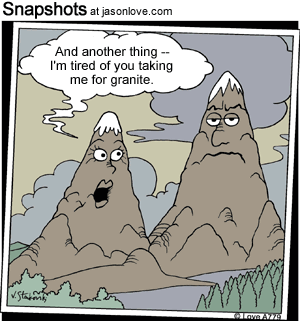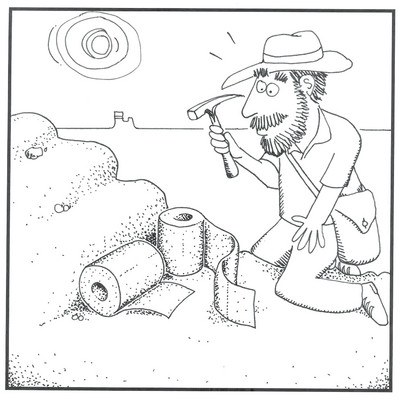Sedimentary Rocks Quiz Questions

How much do you know about rocks? How are they formed? Let's see how much do remember about rocks? Want to Know Your Brain Capacity. Take the quiz and find out.
Quiz Preview
- 2.
Where are the oldest layers of rock usually found in a cliff made from sedimentary rock?
-
At the top
-
In the middle
-
At the bottom
Correct Answer
A. At the bottomExplanation
The oldest layers of rock are usually found at the bottom of a cliff made from sedimentary rock. This is because sedimentary rocks are formed through the accumulation and compaction of sediment over time. As new layers of sediment are deposited on top, the older layers become buried and compressed, gradually forming solid rock. Therefore, the layers that were deposited first and are the oldest will be located at the bottom of the cliff.Rate this question:
-
- 3.
Only one of these rocks is a sedimentary rock. Which one?
-
Shale
-
Slate
-
Granite
Correct Answer
A. ShaleExplanation
Shale is the correct answer because it is a type of sedimentary rock. Sedimentary rocks are formed from the accumulation and compaction of sediment over time. Shale specifically is formed from clay, silt, or mud that has been compacted and lithified. On the other hand, slate and granite are both types of metamorphic rocks, which are formed from the transformation of pre-existing rocks due to high heat and pressure.Rate this question:
-
- 4.
Which one of these rocks is an igneous rock?
-
Marble
-
Limestone
-
Basalt
Correct Answer
A. BasaltExplanation
Basalt is an igneous rock because it is formed from the solidification of molten lava or magma. It has a fine-grained texture and is typically dark in color. Marble and limestone, on the other hand, are both sedimentary rocks formed from the accumulation and compression of organic or inorganic sediments.Rate this question:
-
- 5.
Which of the following is the order for forming sedimentary rocks?
-
Sedimentation - cementation - compaction
-
Compaction - sedimentation - cementation
-
Sedimentation - compaction - cementation
Correct Answer
A. Sedimentation - compaction - cementationExplanation
The correct order for forming sedimentary rocks is sedimentation, compaction, and cementation. Sedimentation refers to the process of particles settling and accumulating on the Earth's surface. Compaction occurs when the weight of overlying sediment compresses the accumulated particles, reducing the pore spaces between them. Finally, cementation takes place when minerals precipitate and fill in the remaining pore spaces, binding the sediment particles together to form a solid rock.Rate this question:
-
- 6.
Which type of rock never contains fossils?
-
Sedimentary
-
Igneous
-
Metamorphic
Correct Answer
A. IgneousExplanation
Igneous rock is formed from the solidification of molten material, such as lava or magma. This process does not typically allow for the preservation of fossils, as the high temperatures involved would destroy any organic material. Sedimentary rock, on the other hand, is formed from the accumulation and compaction of sediment, which can often contain fossils. Metamorphic rock is formed from the alteration of existing rock through heat and pressure, and while it can sometimes contain fossils, they are usually highly distorted and difficult to recognize. Therefore, igneous rock is the type of rock that never contains fossils.Rate this question:
-
- 7.
What does the presence of tiny crystals in a piece of igneous rock tell you about it?
-
The molten rock cooled very quickly
-
The molten rock cooled very slowly
-
The molten rock cooled deep underground
Correct Answer
A. The molten rock cooled very quicklyExplanation
The presence of tiny crystals in a piece of igneous rock suggests that the molten rock cooled very quickly. When magma cools rapidly, there is not enough time for large crystals to form, resulting in the formation of small crystals or even a glassy texture. This indicates that the rock was likely formed from a volcanic eruption or a rapid cooling event near the Earth's surface.Rate this question:
-
- 8.
Which statement about metamorphic rocks is correct?
-
They are formed when rocks are heated until they melt
-
They are only formed from heated sedimentary rocks
-
They are formed from all types of rock
Correct Answer
A. They are formed from all types of rockExplanation
Metamorphic rocks are formed from all types of rock. This is because metamorphism occurs when pre-existing rocks undergo changes in response to heat, pressure, and/or chemical reactions, without melting completely. This process can affect any type of rock, including igneous, sedimentary, and even other metamorphic rocks. As a result, metamorphic rocks exhibit a wide range of textures and mineral compositions, reflecting the original rock's characteristics and the specific conditions of metamorphism.Rate this question:
-
Quiz Review Timeline (Updated): Mar 22, 2023 +
Our quizzes are rigorously reviewed, monitored and continuously updated by our expert board to maintain accuracy, relevance, and timeliness.
-
Current Version
-
Mar 22, 2023Quiz Edited by
ProProfs Editorial Team -
Jun 06, 2010Quiz Created by
Ukrockstheworld









